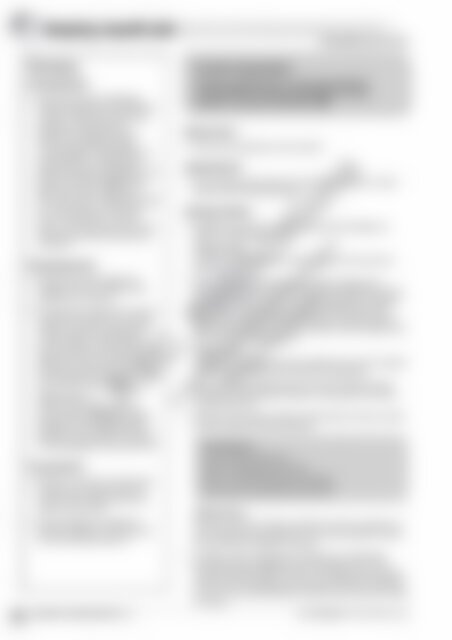RIC-20003 AC Health (Year 1) Be healthy safe and active
You also want an ePaper? Increase the reach of your titles
YUMPU automatically turns print PDFs into web optimized ePapers that Google loves.
The lesson<br />
Introduction<br />
• Discuss the types of situations<br />
where students feel uncomfortable,<br />
un<strong>safe</strong> or need help. Encourage<br />
students to share personal<br />
experiences. What would you<br />
do if you were feeling un<strong>safe</strong>,<br />
uncomfortable or needed help? In<br />
brief sentences or bullet points,<br />
quickly write some strategies on the<br />
board as students suggest them.<br />
Ideas may include 'Tell Mum or<br />
Dad', 'Run away', 'Yell/Scream', 'Say<br />
in a strong voice "No! Go away!"',<br />
'Run to a <strong>safe</strong> place', 'Call the<br />
police', 'Don't let anyone touch you',<br />
'Take deep breaths <strong>and</strong> stay calm'<br />
<strong>and</strong> so on.<br />
Development<br />
• Discuss what characteristics a<br />
trusted person has. Who are the<br />
people you trust most?<br />
• Provide each student with a copy of<br />
page 23 <strong>and</strong> ask them to write the<br />
name of a specific trusted person<br />
on each finger. Provide specific<br />
phone numbers of local community<br />
organisations such as Kids Helpline,<br />
triple zero, child services <strong>and</strong> so on<br />
for the students to copy down on the<br />
wrist section of the diagram.<br />
Differentiation<br />
Assist students who need help<br />
writing words; allow more capable<br />
students to work independently.<br />
Students may add phone numbers<br />
of trusted people if they know them.<br />
Conclusion<br />
• Gather in a circle as a whole class<br />
<strong>and</strong> ask each student to say the<br />
name of one trusted person they<br />
wrote on their 'h<strong>and</strong>'.<br />
• Ask the students to repeat the<br />
phrase, 'Nothing is so bad that we<br />
can't tell someone about it!'.<br />
22 Australian Curriculum <strong>Health</strong> (<strong>Year</strong> 1)<br />
Content description<br />
<strong>Be</strong>ing <strong>healthy</strong>, <strong>safe</strong> <strong>and</strong> <strong>active</strong><br />
Practise strategies they can use when they feel<br />
uncomfortable, un<strong>safe</strong> or need he!e.._ with a task,<br />
problem or situation (<strong>AC</strong>PPS017) QJ<br />
Resources<br />
• One copy of page 23 for each student<br />
Assessment<br />
• Oral responses will indicate if students can identify a trusted<br />
person to tell if they feel un<strong>safe</strong>.<br />
Going further<br />
• Read the scenarios on page 25 <strong>and</strong> discuss strategies (or<br />
plans) for keeping <strong>safe</strong>.<br />
Differentiation<br />
Students may be grouped in pairs to discuss the scenarios<br />
with a friend.<br />
• Read books like the following that reinforce ideas about<br />
keeping private parts private: Some Parts are NOT for sharing<br />
by Julie K. Federico, I said no!: a kid-to-kid guide to keeping<br />
pr i vate parts private by Zach King <strong>and</strong> Kimberly King, My<br />
underpants rule! by Kate <strong>and</strong> Rod Power, <strong>and</strong> Some secrets<br />
should never be kept by Jayneen S<strong>and</strong>ers. After reading a text,<br />
the students complete page 24.<br />
Differentiation<br />
Select books appropriate to the students in the class. Capable<br />
students may be able to read some for themselves.<br />
• Visit to play 'Triple zero kids'<br />
challenge'. Provide opportunities for the students to practice<br />
phoning triple zero.<br />
©R.I.C. Publications<br />
Low Resolution Images<br />
Display Copy<br />
• Read the poem below with the students then ask them to paint<br />
or draw a picture of their <strong>safe</strong> place.<br />
My <strong>safe</strong> place<br />
I have a place I like to go<br />
When I am feeling sad <strong>and</strong> low.<br />
When I am there I feel <strong>safe</strong> <strong>and</strong> happy.<br />
Do you have a <strong>safe</strong> place just like me?<br />
Differentiation<br />
Once the picture has dried, students may write a sentence or<br />
two to describe their <strong>safe</strong> place. This can be stapled or glued<br />
to their picture for display or sharing.<br />
• Consider using the educational resources at . They<br />
include information about 'yes' <strong>and</strong> 'no' feelings, warning signs,<br />
scared <strong>and</strong> yucky feelings, private parts <strong>and</strong> privacy, the right<br />
to say no if you don't feel <strong>safe</strong>, <strong>and</strong> what to do if you feel un<strong>safe</strong><br />
or unsure.<br />
R.I.C. Publications ® www.ricpublications.com.au


















